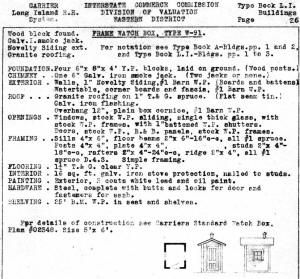
ICC Division of Valuation LIRR Watchman Shanty Type W-96 page 26 8/26/1916
Archive: Dave Morrison |
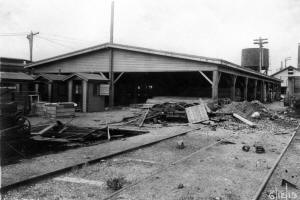
Holban Yard Lumber Shop - Crossing shanties under construction Photo: LIRR
valuation 6/12/1919
Archive: Dave Morrison
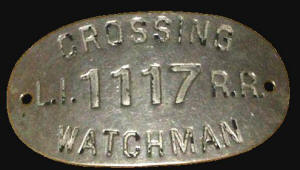
Crossing Watchman Cap badge c.1920s
Archive: Yardgoat |
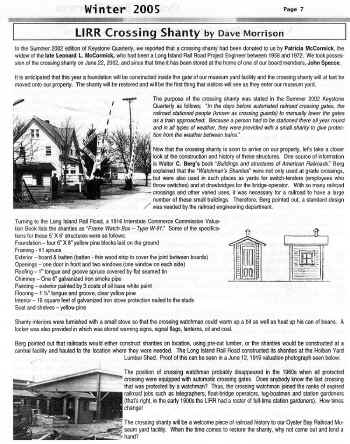
LIRR Crossing Shanty- Cannonball
by Dave Morrison 11/2005 |
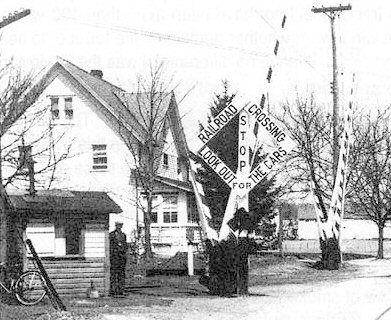
Watchman Crossing Shanty - Ocean Ave, Malverne view N Archive: Dave Morrison
|
|
PATCHOGUE SHANTIES
|
|

Map design: Steven Lynch Research: Dave
Keller
|
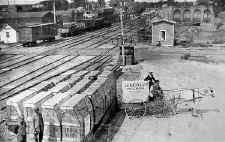
View west of 4 stall engine house from
the roof of the brick freight house
c. 1910 W. J. Rugen
Collection: SUNY, Stony Brook, NY |
West Avenue was ORIGINALLY on the EAST side
of the crossing as is evident in the Ackerly Piano shot of the engine
house. Once the Hostler's House was
moved to the end of the siding adjacent to the turntable, the crossing
shanty was moved/rebuilt where you've got it indicated on your map.
I have no idea when the transformation took place.
THEN . . after 1963, a
NEW, metal crossing shanty was erected at West Avenue again on the EAST
side of the crossing. . . . All shanties at West Ave. were NORTH of the
tracks.
Research: Dave Keller
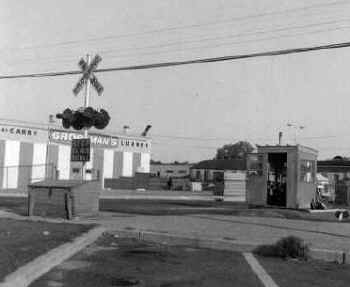
West Ave Replacement Shanty view
NW 1968
Photo/Archive: Dave Keller
|
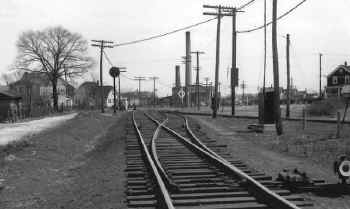
River Ave view
E to PELCO Plant 4/24/1946
Photo: Fred Weber Archive: Dave Keller |
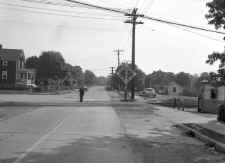
River Ave View S 10/1943
Photo: Fred Weber Archive: Dave Keller |
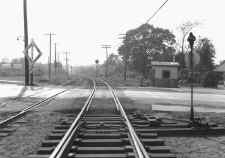
River Ave Underwood
Coal & Coke View W 10/1943
Photo: Fred Weber Archive: Dave Keller |
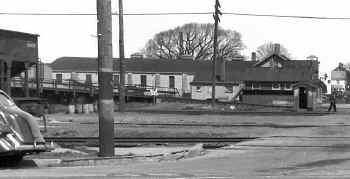
West Ave view N Coaling Ramp
05/1943
Photo: Fred Weber Archive: Dave Keller
|
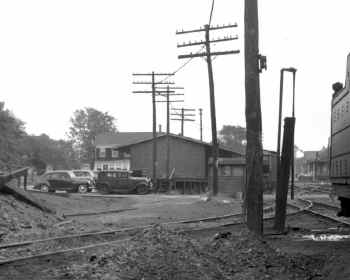
West Ave view E Freight House 09/1944
Photo: Fred Weber Archive: Dave Keller
|
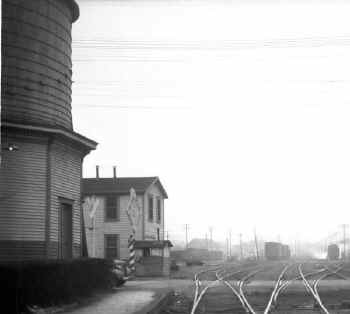
Railroad Ave view W 03/02/1946
Photo: Fred Weber Archive: Dave Keller |
|
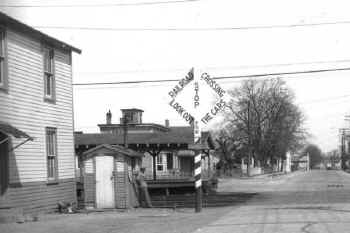
Railroad Ave view N 05/1943
Photo: Fred Weber Archive: Dave Keller
|
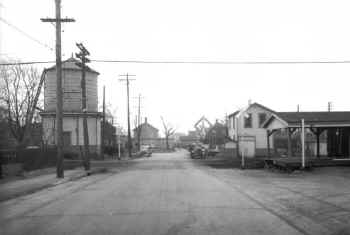
Railroad Ave view S 03/1946
Photo: Fred Weber Archive: Dave Keller
|
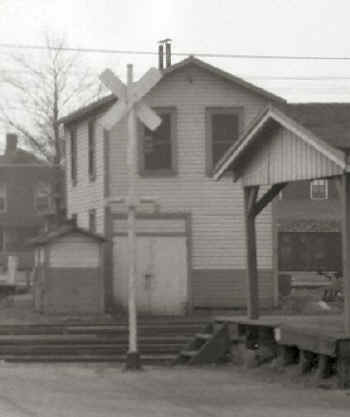
Railroad Ave close-up view S 03/1946
Photo: Fred Weber Archive: Dave Keller |
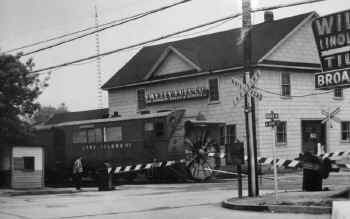
Rider Ave view SE Photo: R. Ziel
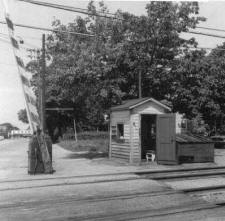
Rider Ave - View N 1968
Photo/Archive: Dave Keller
|
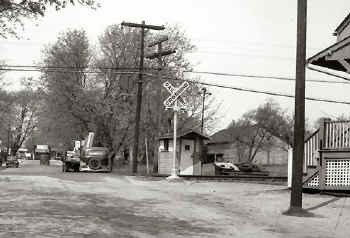
Bay Ave view N
4/24/1946
Photo: Fred Weber Archive: Dave Keller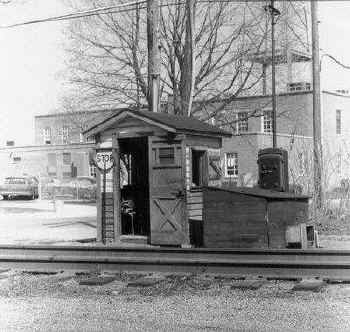
Bay Ave view N
1968
Photo/Archive: Dave Keller
|
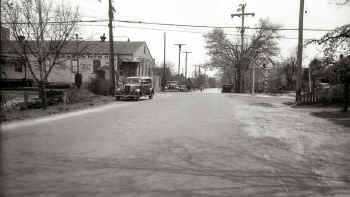
Bay Ave view S
4/24/1946
Photo: Fred Weber Archive: Dave Keller
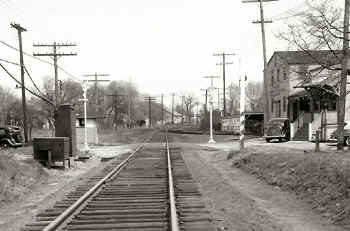
Bay Ave view E 4/24/1946
Photo: Fred Weber Archive: Dave Keller
|
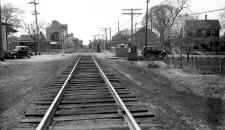
Bay Ave view W 4/24/1946
Photo: Fred Weber Archive: Dave Keller |
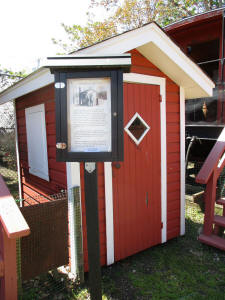
Ex-Bay Ave crossing shanty - Oyster Bay Railroad Museum 5/30/2021
Photo/Archive: Dave Morrison |
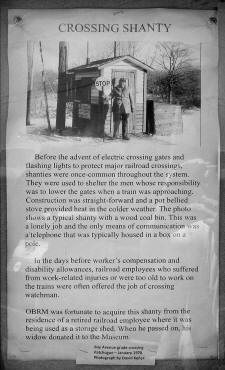
Ex-Bay Ave crossing shanty sign with 1970 Dave Keller photo.
OBRM 5/30/2021 Photo/Archive: Dave Morrison |

Crossing shanty gateman view W - 1946 Buick Sedanette
Archive: Mitchell Perlman |
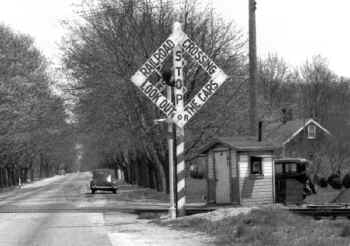
South Country Road view S
Photo: Fred Weber Archive: Dave Keller |
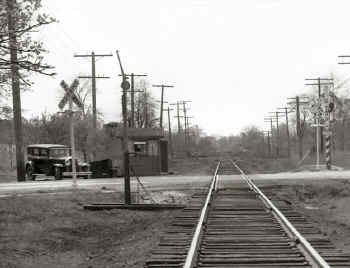
South Country Road view W, Mail
Crane for the East Patchogue Post Office - 4/24/1946
Photo: Fred Weber Archive: Dave Keller
|
|
Each
shanty had an electric box connected to the track circuit. There would be 2 lights . . . one marked Eastbound and one marked
Westbound.
When
a train entered the circuit, the light would go on emitting a noise
to attract the attention of the crossing watchman.
He'd
then go out and hold up his stop sign, or red lantern or lower the gates
if his crossing was so equipped. He
had to be notified well in advance, because he'd have to have time to go
across the tracks and lower the far side gates, by hand cranking them and
then return and lower the near side gates by hand cranking them.
Assuming
this was an express train traveling at 70 mph and not intending to stop,
he had to move his ass.
Then
there were the REALLY busy guards who worked double track territory,
especially electric territory. Trains
ran along the Babylon-Jamaica portion of the Montauk branch every 30
minutes in each direction. That
was a lot of light indicators flashing, and crossing watchmen running back
and forth to lower both sets of gates . . . especially when an eastbound
AND a westbound passed each other at or near his crossing!
You
may have fallen asleep on the job had you been guarding the crossing at
South Country Road east of Patchogue, but you'd be quite awake if you were
guarding the crossing at Little East Neck Road west of Babylon or even
Deer Park Avenue for that matter with trains going in and out of the yard
east of the station! BTW: Each had its
own pot-bellied stove. Research: Dave Keller
|
|
Multiple Crossing
Watchman/Shanties - Patchogue
|
|
Hicksville and
Babylon (1962-64 and 1963-64, respectively) were not the last locations of
multiple crossing watchmen.
I photographed
the crossing shanties at Patchogue between 1968 and 1972 on multiple
occasions (i.e. 1966, 1967, 1968, 1970, 1971, 1972) with the exception of
South Country Road because I never knew there was one there at the time.
Perhaps there wasn't and it was already gone . . . who knows. I never
ventured that far east from PD tower as a teenager on my bike.
I believe the
shanties were all gone starting sometime in 1973. I stopped hanging
around the tower after 1972 and was full-time as a junior at SUNY @ Stony
Brook and no longer had the free time to hang out, otherwise I'd have been
made privy as to when the shanties were being removed and I'd have made it a
point to get some photos of their removal.
Also, it was one
of those quick changes where I drove by the crossing one day and the shanty
and watchman was there and I drove by it a week or so later and said "WTF?
Where'd the shanties go?"
There were
simultaneously-manned crossings one avenue apart from each other:
River Ave., West Ave., Ocean Ave. (PD tower), Rider Ave., Bay Ave.
Railroad Ave. no
longer existed as a crossing after the 1963 rebuild of the station
facilities and yard, however West Avenue got a new metal shanty as a result
of the rebuild. Perhaps the West Ave. shanty was more decrepit than
the others and needed replacement, or perhaps it fell apart upon removal.
You'd think they
would have saved a buck and moved the Railroad Ave. shanty one avenue over
to West as the replacement, but they didn't.
River, Rider and
Bay all retained the original wooden shanties, but they were well out of the
rebuild zone. That may have had something to do with their original
structures being left in situ.
There was NO
buzzer or communication between the crossing shanties at PD tower. No,
there was no crossing watchman.
The towerman had
the model board that showed the approaching trains with lights that lit up
on the board. The block operator flipped on the Ocean Ave. flashing
lights by switch and hand-cranked the gates down from the 2nd storey of the
tower until the manual gates were replaced by automatic ones with flashing
lights in 1969. Then the old cranking assembly and linkage was removed
from the tower. Technically, as block operator, he had the power to stop
said trains if required. All material
above thanks to Dave Keller for the contribution/research/archives.
|
|
LIRR
South Country Rd Crossing, Patchogue
|
|
“… As for the
crossing shanty at South Country Rd, It didn’t exist as of 1962; if it
ever existed. I hit my first car there, on a rainy night in ‘62, while
bringing in the L-50 (west bound Montauk Freight). A young kid had taken his
Father’s brand new station wagon for a ride.
I could see from a
distance that he was going to try to beat the train. There was a speed
restriction from that point into the station and I was already slowing down
(Note*), so when I put the train into emergency I only went about 10 or 12
cars past the impact point. At the time, we had an Engineer, Fireman,
Conductor, Flagman and Head end man (Pin Puller).The Head end man and I
walked back and found the car that just cleared the ROW. (Note**)
The car was hit
about a foot in from the rear. The windshield was blown out and the kid was
still sitting in the driver’s seat. When I looked at him through the open
windshield he asked me, "What’s my father gonna say?” I told him he
was gonna call him a s**t head and I grabbed him to pull him out.
When the cop drove
up and asked ME what I was going to do. I told him that the kid wasn’t
hurt, but I was going to beat the crap out of him. Funny, this was one of
the few times I wasn’t sued or threatened with arrest…”
Note: *
When I was new on the RR, there was a speed restriction on all trains coming
into Patchogue, I believe it was 40 mph, due to the many unprotected close
crossings.
Note: **
It was not unusual to have a large crew on double ended freights. This is at
a time before radios, when hand signs had to be used with 70 or 80 cars when
switching. We had large trains with roofwalks on top of the cars that
allowed the men giving signs to be up high, very helpful around curves.
Thanks to Ed Schleyer for the contribution.
|
|
Central Islip
|
|
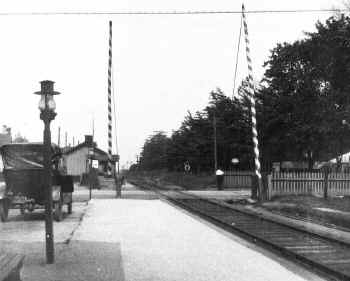
Central Islip, Carleton Ave view E
c.1918 Photo: George G. Ayling Archive: Dave Keller
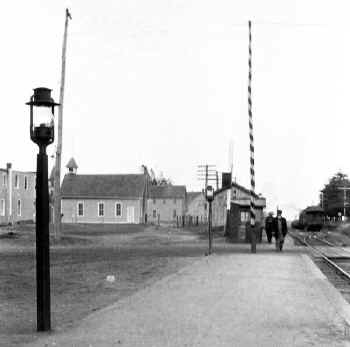
Central Islip, Carleton Ave view E
c.1918 Photo: George G. Ayling Archive: Dave Keller
|
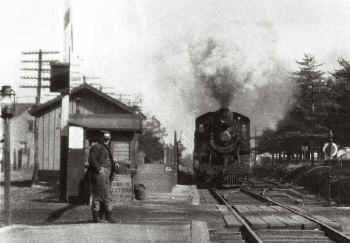
Central Islip, Carleton Ave view E
E51sa Camelback c.1918 Photo:
George G. Ayling
Archive: Dave Keller
The sign on the structure states
the crossing is protected between certain hours. Mail crane in the
center background in line with the locomotive.
Express house beyond
shanty. Central Islip State Hospital siding/spur coming off main just
east of the crossing.
A great shot taken from in front
of the depot and zoomed in. Ayling probably had to snap the image then
set the camera down and hold
the order hoops up. Couldn't do it
if he got closer to the crossing.
|
|
Elevated Crossing Shanties |
%20-%2007-27-1930_Sperr-Keller_small.jpg)
Autumn Ave. Brooklyn - Elevated Crossing Gate Tower
View SE 7/27/1930 (Sperr-Keller)
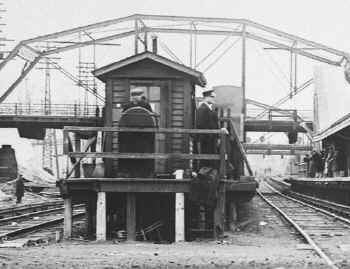
Guard at Union Hall Street Jamaica
12/16/1929
|
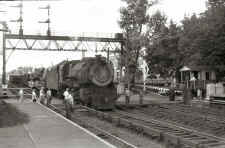
Floral Park at Carnation Ave. 1951 Elevated crossing shanty so the
watchman could see OVER the high-level platforms Info/Archive: Dave Keller
|
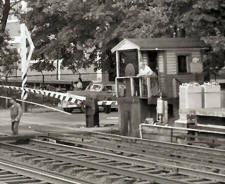
When
Floral Park station was relocated and replaced in 1909, the platforms were
low. The crossing
shanties at Carnation and Tulip Avenues were standard
shanties built at grade. When the
high-level platforms
were installed some years later, the visibility from these shanties was
blocked by the high-levels, so the shanties were jacked up and the bottom
enclosed. Info/Archive: Dave Keller
|
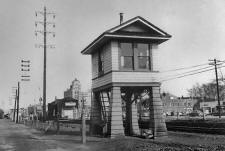
Freeport elevated crossing tower controlling
N. Bergen Pl. and N. Ocean Ave., per Robert Emery 1958 map - View E 1955 |

Elevated crossing shanty at Lefferts Blvd. view S and Atlantic Ave. on the
west side of the Morris Park Station. 5/07/1935 - Archive: Kevin Katta |
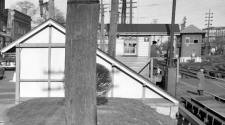
Floral Park - Pedestrian walk-under at Tulip Ave. crossing, view E, with
"PARK" tower in the right background and also visible is the branch to
Hempstead. c.1944 (Weber-Morrison) |
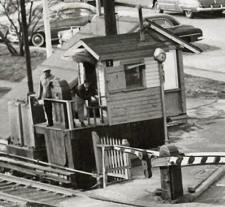
Tulip
Ave, Floral Park zoom Elevated crossing shanty - View N/NW C.1950 |
|
Other Shanty Locations
|
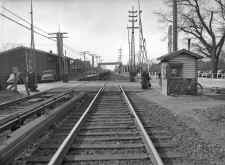
Amityville shanty 02/15/1946
Archive: Dave Morrison
|
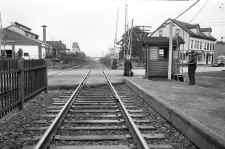
Bethpage 10/1944 Archive: Dave
Morrison
|
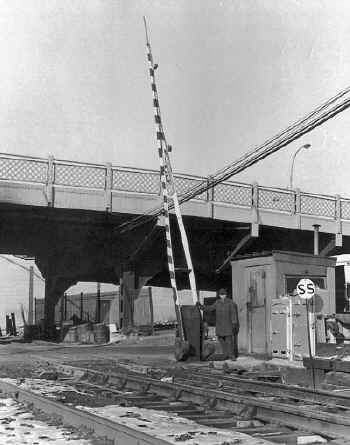
Greenpoint Ave Blissville 12/25/1970
(Dave Keller photo and archive) |
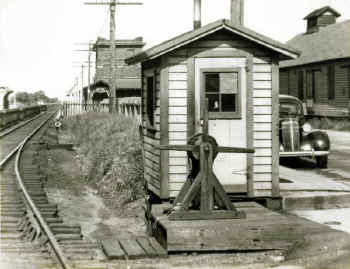
Farmingdale c.1946 view
E
Photo: Fred Weber Archive: Dave Keller
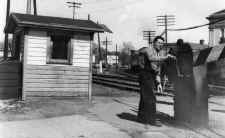
Watchman lowering gates at
Broadway St. Hicksville 1959 Archive: MTA
|
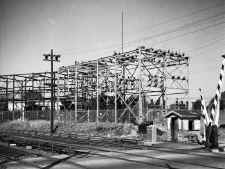
Crossing Shanty and Power Grid Plainfield Ave. Floral Park Hempstead
Branch view NE 10/12/51 (Faxon-Keller)
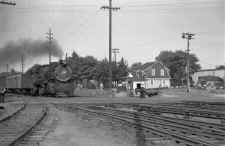
Crossing Shanty Plainfield Ave G5s LIRR #38 train view W at junction of
Creedmoor Branch Floral Park c. 1950
|
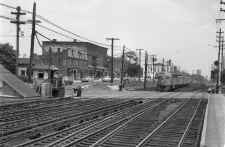
FM CPA24-5 #2401 in Tichy color scheme is westbound approaching the
Tulip Avenue crossing. It's a 3-car train so most probably from Oyster
Bay. It's on the express track so it's not going to make the station
stop, which was designated primarily for Hempstead trains. The
crossing watchman has just lowered the gates. Shanty has been elevated
to see past the station high-level platforms and give the crossing watchman
better visibility down the tracks in each direction. This was also
done at Carnation Avenue, the first crossing west of the station.
Notice the crossing shanty has the letter "T" on the wall telling
train crews that the telephone which is usually inside the "T" box
with the letter "T" outside, is, in this case, located INSIDE the
crossing shanty for train crew use. View is east. "PARK" tower
and the junction of the Hempstead branch is visible in the right background.
c. 1955 (Dave Keller archive)
|
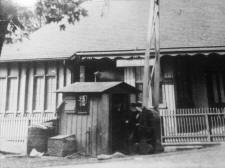
Richmond Hill Station - Crossing Shanty 1900 |
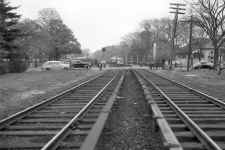
Garden City shanty c.1940s
Archive: Dave Morrison
|
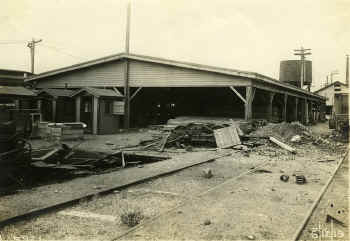
Holban Yard - Shanty production 1919
|
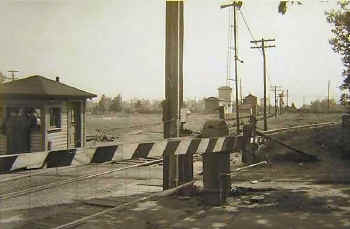
Franklin Ave., Garden City view E towards Hempstead Crossing
c.1930 Archive: Art Huneke |
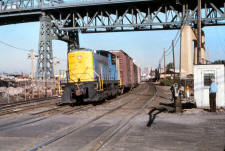
S1 #419 Laurel Hill - Phelps Dodge Plant private grade crossing and shanty.
View west 5/02/1974 Photo: Richard Makse Archive: Dave Keller
Note: Nichols Siding, named after the Nichols Copper Co In the 50's and
60's. |
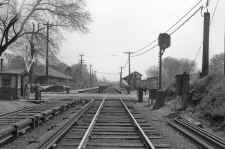
Laurelton shanty 4/30/1946
Archive: Dave Morrison
|
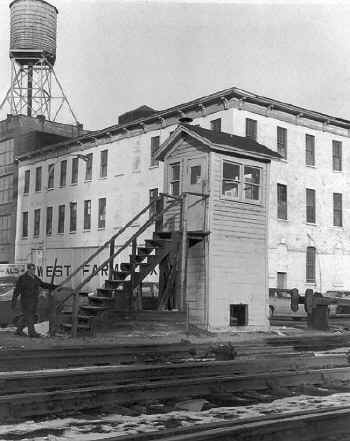
Station crossing tower
5th Street LI City 1/1971
|
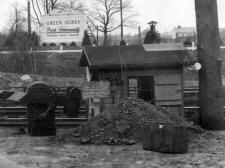
Central Ave., Valley Stream crossing shanty - View S 3/29/1938 (Fred
Weber-Queens Library) |
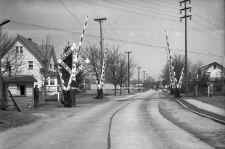
Malverne shanty 5/1943
Archive:
Dave Morrison
|
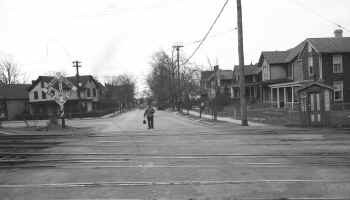
Watchman at Osborne Ave, Riverhead
View S c.1946
Photo: Fred
Weber Archive: Dave Keller
|

CAUTION - Electric rail sign
Photo/Archive: Ben Jankowski |
|
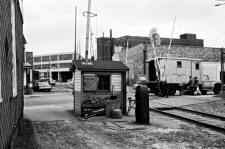
Bushwick Branch - Maspeth 56th Street grade crossing shanty
11/04/1969 - Photo/Archive: Richard F. Makse |
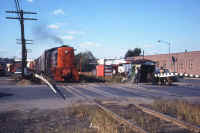
ALCO S2 #445 pulling freight eastbound past crossing shanty and watchman
at Maspeth Ave., Maspeth
9/18/1969 (Makse-Keller) |
|
|
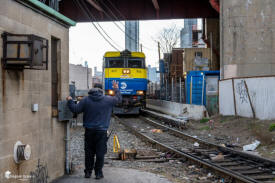
LIRR Crossing Watchman at 11th St. and Borden Ave., LI City
View W 3/31/2023 - Photo/Archive: Gregory Grice |
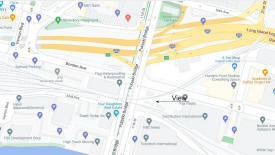 "Farewell to the LIRR Crossing
Watchman" On the afternoon of
Friday March 31st, 2023, Long Island Rail Road's last Crossing Watchman
shares a friendly wave with the engineer of Patchogue-bound Train #80 as it
slowly traverses over 11th Street and Borden Avenue (Pulaski
Bridge overhead) grade crossings in Long Island City, New York. The
watchman's responsibility was to manually activate and deactivate the
crossing protection for trains passing over both streets using two knife
switches located at the watchman's shack. This system was replaced with
modern automatic wheel sensors. "Farewell to the LIRR Crossing
Watchman" On the afternoon of
Friday March 31st, 2023, Long Island Rail Road's last Crossing Watchman
shares a friendly wave with the engineer of Patchogue-bound Train #80 as it
slowly traverses over 11th Street and Borden Avenue (Pulaski
Bridge overhead) grade crossings in Long Island City, New York. The
watchman's responsibility was to manually activate and deactivate the
crossing protection for trains passing over both streets using two knife
switches located at the watchman's shack. This system was replaced with
modern automatic wheel sensors.
This would be one of the last trains the watchman would protect, as this job
was abolished the following weekday on April 3rd, 2023, ending a tradition
that has survived over a century. Research/Photo/Archive:
Gregory Grice
|